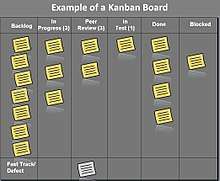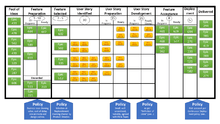Kanban (development)
| Software development |
|---|
| Core activities |
| Paradigms and models |
| Methodologies and frameworks |
| Supporting disciplines |
| Practices |
| Tools |
| Standards and Bodies of Knowledge |
| Glossaries |
Kanban is a lean method to manage and improve work across human systems. This approach aims to manage work by balancing the demands with available capacity, and improving the handling of system level bottlenecks.
Work items are visualized to give participants a view of progress and process, from start to finish usually via a Kanban board. Work is pulled as capacity permits, rather than work being pushed into the process when requested.
In knowledge work and software development, this provides a visual process management system which aids decision-making about what, when and how much to produce. Although the underlying Kanban method originated in lean manufacturing[1] (inspired by the Toyota Production System[2]) it is used mainly for software development and technology related work. However Kanban can be applied to any area of work, and it can even be combined with other methods or frameworks such as Scrum.[3]
Overview
David Anderson's 2010 book, Kanban,[4] describes the method's evolution from a 2004 project at Microsoft[5] using a theory of constraints approach and incorporating a drum-buffer-rope (which is comparable to the kanban pull system), to a 2006-2007 project at Corbis in which the kanban method was identified. In 2009, Don Reinertsen published a book on second-generation lean product development[6] which describes the adoption of the kanban system and the use of data collection and an economic model for management decision-making. Another early contribution came from Corey Ladas, whose 2009 book Scrumban[7] suggested that kanban could improve Scrum for software development. Ladas saw Scrumban as the transition from Scrum to Kanban. Jim Benson and Tonianne DeMaria Barry published Personal Kanban,[8] applying Kanban to individuals and small teams, in 2011. In Kanban from the Inside (2014),[9] Mike Burrows explained kanban's principles, practices and underlying values and related them to earlier theories and models. Kanban Change Leadership (2015), by Klaus Leopold and Siegfried Kaltenecker,[10] explained the method from the perspective of change management and provided guidance to change initiatives. A condensed guide to the method was published in 2016, incorporating improvements and extensions from the early kanban projects.[11]
Principles
Kanban is an approach to process change for organizations which uses visualization with a kanban board, allowing a better understanding of work and workflow. It advises limiting work in progress, which reduces waste from multitasking and context switching, exposes operational problems and stimulates collaboration to improve the system.[12] Kanban is rooted in two sets of principles, for change management and service delivery, which emphasize evolutionary change and customer focus. The method does not prescribe a specific set of steps, but starts from existing context and stimulates continuous, incremental and evolutionary changes to the system. It aims to minimize resistance to change to facilitate it.
Kanban focuses on the customer and work which meets their needs, rather than individuals' activities. Kanban has six general practices: visualization, limiting work in progress, flow management, making policies explicit, using feedback loops, and collaborative or experimental evolution. They involve seeing the work and its process and improving the process, keeping and amplifying useful changes and learning from, reversing and damping the ineffective.
Kanban boards
Although Kanban does not require that the team or organization use a Kanban board, it is the preferred way to see the flow of work, get the participation of the team, and manage work.
A Kanban board shows how work moves from left to right, each column represents a stage within the value stream. For that reason unlike Scrum task boards, Kanban boards can span many teams, and even whole departments or organizations.
The image below is a typical view of a simplified Kanban board, where work items move from left to right. In addition Kanban recommends that each column has a work in progress limit. This means that each column can only receive a fixed amount of work items, these limits encourage focus, and make system constraints evident.

Examples
Software development

The diagram here and the one in the Kanban Board section shows a typical software development workflow.[13] The boards, designed for the context in which they are used, vary considerably and may show work item types ("features" and "user stories" here), columns delineating workflow activities, explicit policies, and swimlanes (rows crossing several columns, used for grouping user stories by feature here). The aim is to make the general workflow and the progress of individual items clear to participants and stakeholders.
Other uses
Although it is usually used for software development and software teams, the kanban method has been applied to other aspects of knowledge work.[14] As a visualization and control mechanism, any repeatable and consistent workflow can be tracked regardless of complexity or subject area. Business functions which have used kanban include:
- Human resources[15] and recruitment[16]
- Marketing
- Organizational strategy and executive leadership[17]
See also
References
- ↑ James P. Womack (2007). The Machine That Changed the World. ISBN 978-1847370556.
- ↑ Taiichi Ohno (1988). Toyota Production System: Beyond Large-Scale Production. ISBN 978-0915299140.
- ↑ Corey., Ladas, (2008). Scrumban and other essays on Kanban System for Lean Software develoment. Seattle, Washington: Modus Cooperandi Press. ISBN 9780578002149. OCLC 654393465.
- ↑ Anderson, David J. (April 2010). Kanban: Successful Evolutionary Change for Your Technology Business. Blue Hole Press. ISBN 0-9845214-0-2.
- ↑ Anderson, David J. and Dragos Dumitriu. "From Worst to Best in 9 Months: Implementing a Drum-Buffer-Rope Solution at Microsoft’s IT Department". TOC ICO World Conference November 2005. USA: Microsoft Corporation, 2005.
- ↑ Reinertsen, Donald (May 2009). The Principles of Product Development Flow: Second Generation Lean Product Development. Celeritas Publishing. ISBN 978-1935401001.
- ↑ Ladas, Corey (January 2009). Scrumban: Essays on Kanban Systems for Lean Software Development. Modus Cooperandi Press. ISBN 978-0578002149.
- ↑ Benson, Jim; DeMaria Barry, Tonianne (January 2011). Personal Kanban: Mapping Work, Navigating Life. Modus Cooperandi Press. ISBN 978-1453802267.
- ↑ Burrows, Mike (2014). Kanban From The Inside. Seattle, WA: Blue Hole Press. ISBN 978-0-9853051-9-2.
- ↑ Leopold, Klaus; Siegfried, Kaltenecker (2015). Kanban Change Leadership. Hoboken, NJ: John Wiley & Sons. ISBN 978-1-119-01970-1.
- ↑ Anderson, David J.; Carmichael, Andy (2016). Essential Kanban Condensed. Seattle, WA: Lean Kanban University Press. ISBN 978-0-9845214-2-5.
- ↑ Scotland, Karl. "Aspects of Kanban". Retrieved 13 November 2014.
- ↑ Jasper Boeg (February 2012). "Priming Kanban". InfoQ. Retrieved 2014-02-17.
- ↑ Leybourn, E. (2013). Directing the Agile Organisation: A Lean Approach to Business Management. London: IT Governance Publishing: 160–66.
- ↑ "Kanban for Short Intense Projects: How We Used Kanban to Visualize Our Hiring Process Workflow and Make Our Lives Easier". Personal Kanban. 2011-01-19. Retrieved 2012-08-17.
- ↑ "Kanban and Recruitment". The Social Tester. 2014-08-06. Retrieved 2015-06-08.
- ↑ "New Zealand Post Group - An Agile Executive!". Agile Business Management Consortium. 2013-12-02. Retrieved 2015-06-08.
Further reading
- Kanban: Successful Evolutionary Change for Your Technology Business, David J. Anderson. (United States, Blue Hole Press, 2010. ISBN 978-0984521401
- Scrumban: Essays on Kanban Systems for Lean Software Development, Corey Ladas. (United States, Modus Cooperandi Press, 2009. ISBN 9780578002149
- Agile Project Management with Kanban (Developer Best Practices), Eric Brechner. (United States: Microsoft Press, 2015). ISBN 978-0735698956.
- Kanban in Action, Marcus Hammarberg and Joakim Sunden. (Shelter Island, NY: Manning Publications, 2014). ISBN 978-1-617291-05-0.
- Lean from the Trenches: Managing Large-Scale Projects with Kanban, Henrik Kniberg. (Dallas, TX: The Pragmatic Programmers, 2012). ISBN 978-1-93435-685-2.
- Stop Starting, Start Finishing! Arne Roock and Claudia Leschik. (USA: Lean-Kanban University, 2012). ISBN 978-0985305161.
- Real-World Kanban: Do Less, Accomplish More with Lean Thinking, Mattias Skarin. (United States: Pragmatic Bookshelf, 2015). ISBN 978-1680500776.